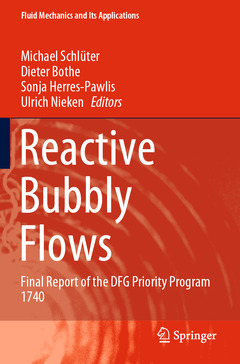Description
Reactive Bubbly Flows, 1st ed. 2021
Final Report of the DFG Priority Program 1740
Fluid Mechanics and Its Applications Series, Vol. 128
Coordinators: Schlüter Michael, Bothe Dieter, Herres-Pawlis Sonja, Nieken Ulrich
Language: English
Subjects for Reactive Bubbly Flows:
Publication date: 07-2022
Support: Print on demand
Publication date: 07-2021
644 p. · 15.5x23.5 cm · Hardback
Description
/li>Contents
/li>Comment
/li>
This book presents experimental and numerical methods that have been developed during six years of targeted research within the DFG priority program SPP 1740, elucidating the interaction between hydrodynamics, mass transfer and transport as well as chemical reactions in bubbly flows. A special feature of this book is its focus on an interdisciplinary research approach with contributions from chemistry, mathematics and engineering sciences, providing enhanced or novel experimental methods, models and numerical simulations. This book provides fundamental knowledge to students about the current state of knowledge regarding transport processes in reactive bubbly flows as well as to scientists, emphasizing pressing research questions and further current demands for fundamental research. Engineers from the chemical industries will get valuable insights into relevant gas-liquid processes and benefit from recommendations concerning the design of gas-liquid reactors and laboratory experiments for studying the performance of gas-liquid reactions in their own lab.
Is the first book dealing with Fluid Mechanics and Chemistry in two-phase flows to understand the interplay between transfer and transport processes at gas-liquid interfaces with liquid-phase chemistry
Gives the deeper knowledge that has been achieved during the six years of the DFG priority program “Reactive Bubbly Flows”
Provides benchmark experiments for future validation of numerical simulations as well as chemical systems for the reader to perform own experiments on this topic
Presents very recent and cutting-edge numerical methods for the detailed simulation of such processes and explains new experimental techniques to study flow and concentration fields
Offers information to business professionals from chemical industry about the state of knowledge and recommendations for laboratory experiments to transfer the knowledge of the SPP 1740 to their own business




